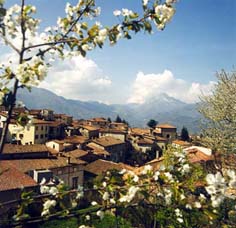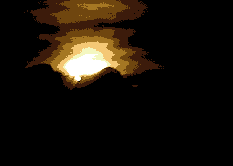|
THE
ARINGO
THE DUOMOTHE PALAZZO PRETORIO AND THE AVELLI.
(Itinerary n° 3)
It
is well worth the effort to climb up the steep steps to the Aringo.
This large open space, with its magnificent view at the highest
point of the Barga hill (also known as the Romeccio hill), is the
place where people gathered in the past to govern and to administer
justice protected by its strong impregnable fortifications.
Here
also is the site of the Duomo, the cathedral of Barga. This imposing
structure, now a national monument, has dominated the territory
of Barga and the Valley of the Serchio for over a thousand years.
If you are going up to the Aringo for the first time, either from
Via del Pretorio or up the steps from Via della Speranza, you will
find it difficult to decide whether to enter the Duomo directly,
or to stop and admire the panorama which nature has so generously
provided.
 |
|
The
Apuan Alps as seen from the Aringo.
|
If
you choose the latter you will see, on the one side, the line
of the Apuan Alps and the Valley of the Serchio and on the other,
behind the Duomo, the Appenine mountains of Tuscany and Emilia-Romagna
whose steep slopes descend all the way down to Barga. But no description
of this spectacular landscape is really adequate. You must see
what has been the inspiration of poets and painters with your
own eyes and your own feelings. It is always beautiful - by day
in the sun or at night with the stars; in spring, summer, autumn
or winter, when the scene changes with the continuous changes
of colour with the seasons, or at sunset when the clouds in the
background are tinged red, or on the 10th and 11th of November
and the 30th and 31st of January, when there is the illusion of
the double sunset.
 |
| The
double sunset |
On
these particular days, the rays of the sun create an optical illusion
as they drop behind Monte Forato. They seem to reverse back onto
the landscape giving an unreal aspect to the travertine facade of
the cathedral and to its carved figures. And there is another illusion,
also unique, to be seen from the Aringo. If you look across at the
group of mountains which include Monte Forato and the Pania you
find that across the horizon their profiles seem to form the outline
of a giant who has been wounded and who is lying down on the bare
earth. This configuration is known as the Dead Man and seems to
be an offering by the Sculptor of the Universe to those on the Aringo
who are straining their eyes to the uttermost limit to take in this
astonishing scene.
From
the back of the Duomo, the view is perhaps less spectacular, but
even here nature has been generous. In the background, the crests
of the Appenine mountains stand out against the sky, and from here
you can see the mountains tops of the Romecchio, the Omo, the Giovo,
and the Rondinaio which mark the border between Tuscany and Emilia-Romagna.
 |
|
The Appenines as seen from the Duomo. |
The
steep slopes of these mountains, which descend as far as Barga,
form a large number of small valleys and streams whose waters flow
into the Serchio River. There are very few villages, or even houses
in these areas and particularly in winter, when the snow is on the
ground, or at night, when there are only a few lights here and there,
you get the impression of an immense primitive landscape.
Turning
now to the Duomo, you will experience, on the inside, an equal sensation
of grandness and of natural beauty. The first construction was begun
in the 10th Century, but this was followed by numerous additions,
enlargements, restructurings and reconstructions right up until
the first half of the 20th Century. The sum total of this work has
created the magnificent cathedral that we see today and although
wars and earthquakes have often threatened to destroy it, the people
of Barga, with faith and good will, have always restored it and
made it stronger and more beautiful. Throughout its history the
voice of its bells has resounded from the bell tower across the
valley and beyond.
next
page
|